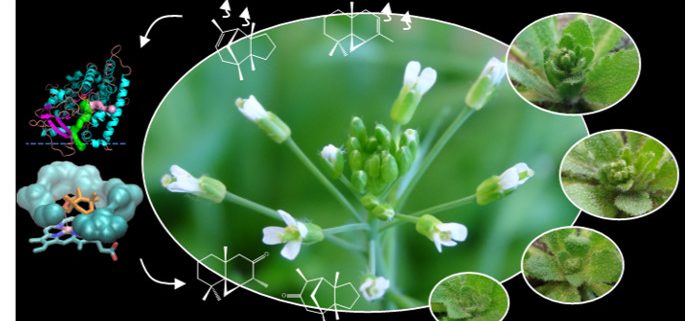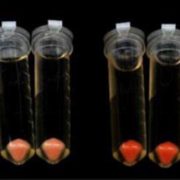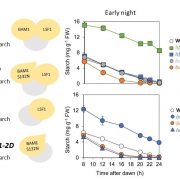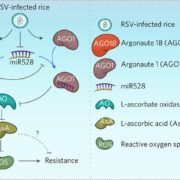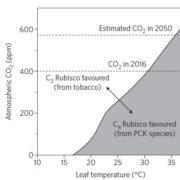Attractive flower smell turned into defense barrier
Boachon et al. explore metabolic processes associated with floral defense.
Plant Cell https://doi.org/10.1105/tpc.19.00320
By Benoît Boachon, University of Lyon, UJM-Saint-Etienne, CNRS, BVpam FRE 3727, Saint-Etienne, France.
Danièle Werck-Reichhart, Institute of Plant Molecular Biology of CNRS, UPR 2357, University of Strasbourg, France
Background: Flowers have an essential role: they ensure plant reproduction. Flowers of the Arabidopsis model plant are small and fragile. They are usually not pollinated by insects and do not emit a perceptible smell. They were however described to emit some volatile compounds, mainly belonging to the class of sesquiterpenes (15 carbon compounds), but in low amounts. They were also reported to emit traces of monoterpenes (10 carbon compounds). We previously showed that the low emission of monoterpene alcohols (monoterpenols) was due to their conversion to oxygenated derivatives retained in the flower tissues. Such oxygenated monoterpenols showed insect-repelling activity. Their production also protected the plant from flower visitors, and from insects feeding on the plant.
Question: We wanted to investigate if the low emission of sesquiterpenes also resulted from their oxygenation by a flower-expressed enzyme (oxygenase). We also wanted to know if such a metabolism would result in the retention of the oxygenated sesquiterpenes in the flowers and if this could impact flower-visiting insects and microorganisms colonizing the flower surface.
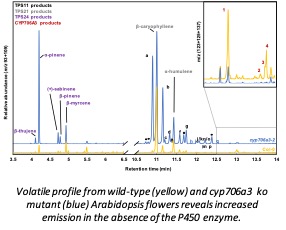 Findings: We found that an oxygenase from the cytochrome P450 family is expressed in the same flower tissues as the enzyme that produces the sesquiterpenes. This enzyme is able to oxygenate many sesquiterpenes emitted by the Arabidopsis flowers. It also oxygenates some monoterpenes. We also found that the oxygenated sesquiterpenes and monterpenes are retained in the flower tissues. Mutants in which the oxygenase was inactivated emit large amounts of volatile monoterpenes and sesquiterpenes. Production of oxygenated sesquiterpenes also occurs in the flower buds during flower development.
Findings: We found that an oxygenase from the cytochrome P450 family is expressed in the same flower tissues as the enzyme that produces the sesquiterpenes. This enzyme is able to oxygenate many sesquiterpenes emitted by the Arabidopsis flowers. It also oxygenates some monoterpenes. We also found that the oxygenated sesquiterpenes and monterpenes are retained in the flower tissues. Mutants in which the oxygenase was inactivated emit large amounts of volatile monoterpenes and sesquiterpenes. Production of oxygenated sesquiterpenes also occurs in the flower buds during flower development.
We then tested the behavior of visiting insects on the oxygenase mutants and showed that sesquiterpene oxygenation results in flower bud protection against insects feeding on the plant. Furthermore, terpene oxygenation modifies the composition of the flower microbial population.
Next steps: Flower defense and optimal fertility rely on complex interactions between bacteria, insects and plants. Their mutual interplay on the different parts of the flower and at different stages of the flower development have now to be further clarified, as well as the respective roles of retained oxidized sesqui- and monoterpenes.
Benoît Boachon, Yannick Burdloff, Ju-Xin Ruan, Rakotoharisoa Rojo, Robert R. Junker, Bruno Vincent, Florence Nicolè, Françoise Bringel, Agnès Lesot, Laura Henry, Jean-Etienne Bassard, Sandrine Mathieu, Lionel Allouche, Ian Kaplan, Natalia Dudareva, Stéphane Vuilleumier, Laurence Miesch, François André, Nicolas Navrot, Xiao-Ya Chen and Danièle Werck-Reichhart. (2019). A Promiscuous CYP706A3 Reduces Terpene Volatile Emission from Arabidopsis Flowers, Affecting Florivores and the Floral Microbiome. Plant Cell; DOI: https://doi.org/10.1105/tpc.19.00320
Key words: chemical ecology, flower, metabolism, terpenes


